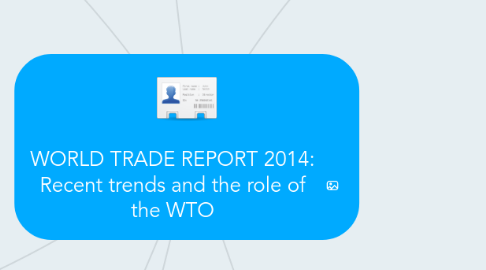
1. A. INTRODUCTION
1.1. 1. the rise of developing world 2. the expansion of global value chains 3.the increase in prices of commodities and the growing importance of commodity exports 4. the increasingly global nature of macroeconomic shocks
1.1.1. Major Waves:
1.1.2. Expansion of international trade
1.1.3. 1st wave: (19th century) industrializing Europe and North America
1.1.4. 2nd wave: (after WWII) restoring of open trade, industrialized economies
1.1.5. 3rd wave: (started 1980s) the most rapid process of industrialization
2. B.THE INCREASING IMPORTANCE OF DEVELOPING COUNTRIES IN THE GLOBAL ECONOMY
2.1. G-20 members have drawn along other developing countries due to their given size, rapid industrialization and greater trade openness. World’s Income distribution: 3 peaks 1. Poor developing economies 2. Rich developed economies 3. Higher growth of many G-20 members
2.2. Trade can increase GDP
2.3. Improving resource allocation (comparative advantage/ economies of scale exploited)
2.4. Other indicators of well-being:
2.5. Life expectancy at birth
2.6. Infant mortality
2.7. Nutrition
2.8. Literacy
2.9. Gender inequality
2.10. Employment
2.11. Important Facts:
2.12. 1. Higher per-capita GDP may not benefit if inequality increases
2.13. 2. Technological change and government policies exert influence on inequality
2.14. 3. Relationship between growth and environmental quality
2.15. 4. Developing countries have reduced MFN tariffs
3. E.INCREASED SYNCHRONIZATION AND GLOBALIZATION OF MACROECONOMIC SHOCKS
3.1. Macroeconomic volatitlity
3.1.1. Protectionist response to the crisis in not the correct answer
3.1.1.1. Uncertainty
3.1.1.2. Policy substitution
3.1.1.3. microecnomonic policies: Trade restrictive barriers
3.1.2. Links in the world trade have to be part of any coordinated policy response
3.1.2.1. Trade links means smaller demand shock
3.1.2.1.1. Trade may transmit economic shocks but can also become a source of diversification
3.1.3. Microeconomic volatitlity is shown more in developing countries than in developed ones
3.1.4. Low income countries also receive the shock of crisis: Remittances
3.1.4.1. Can recover thanks to internationalisation
3.2. Hamper development
3.3. Lowering on the pace of capital accumulation
3.4. Reduction of economic growth
4. F. THE WTO AND DEVELOPING COUNTRIES
4.1. WTO commitments
4.1.1. Reduction on levels of protection
4.1.1.1. Economic strong performance of deloping countries
4.1.2. Technical assitance
4.1.2.1. good performance of developing countries
4.1.2.2. Help to safeguard tha economic gains achieved by developing countries
4.1.3. Integration or developing countries into the GVC
4.1.3.1. Participation in value chains
4.1.4. WTO supports negotiation
4.1.4.1. Helps to take advantage of the economic potential of a country
4.1.5. Special and different treatment (S&D)
4.1.5.1. less-than full reciprocity in commitments
4.1.5.1.1. Tariff reduction (special tariffs)
4.1.6. Contain protectionism
4.2. Flexibility is important in order to accomplish several goals
4.3. There are sevaral factors that may lead to a slow adjust to open trade
4.3.1. Uncertainty
4.3.2. imperfect financial markets
4.3.3. insufficient governmental resources
5. G. CONCLUSIONS
5.1. Integration into the global economy has gone hand-in-hand with the successful development stories of the last two decades
5.2. Global value chains contribute to integration into the world economy
5.3. Increasing prices have offered commodity exporting countries the opportunity to increase GDP
5.4. There are still obstacles for developing countries to further benefit from the trading system
5.5. The Bali agreement reached important contributions for the multilateral trading system
5.6. TRADE IS ONE OF THE KEY ENABLERS OF DEVELOPMENT
6. D. A NEW ROLE FOR COMMODITIES IN DEVELOPMENT STRATEGIES
6.1. Between 2003-2008 there has been a significant increase in commodity prices (super-cycle) because of the development of growing economies
6.1.1. Price volatility of natural resources
6.1.1.1. It has been higher in the last 5 years than in the previous 2 decades
6.1.1.2. It could persist in te next years
6.1.1.2.1. Food production will have to increase by 70% to feed the population by 2050
6.1.1.2.2. Co-movement between oil and food prices
6.1.2. Agriculture
6.1.2.1. it is the basis of developing countries
6.1.2.1.1. Agriculture employs half of their labour force
6.1.2.2. Its growth cause a significant reduction of poverty
6.1.2.3. Between 2000-2012 it tripled its value and raised 60% of its volume thanks to the integration of agriculture in global markets
6.1.2.4. New agricultural trade
6.1.2.4.1. Raw traditional agricultural exports lowered cosiderably in the last 50 years
6.1.2.4.2. Foreign investment in developing countries
6.1.2.4.3. There is an increase in trade among develping countries (Latin America, Asia and Africa)
6.1.2.4.4. Organisation
6.1.2.4.5. Processed agricultural exports has the largest share, 60% of world
6.1.3. Significant increase in natural resources trade between 2003-2010
6.1.3.1. Metals, mineral ores and fossil fuels tripled its value and raised it volume bt 50%
6.1.3.1.1. Developing countries: Latin America, Caribbean, Sub-saharan africa increased GDP per capita
6.1.3.2. Resource abundance is not a necessary condition for growth and development
